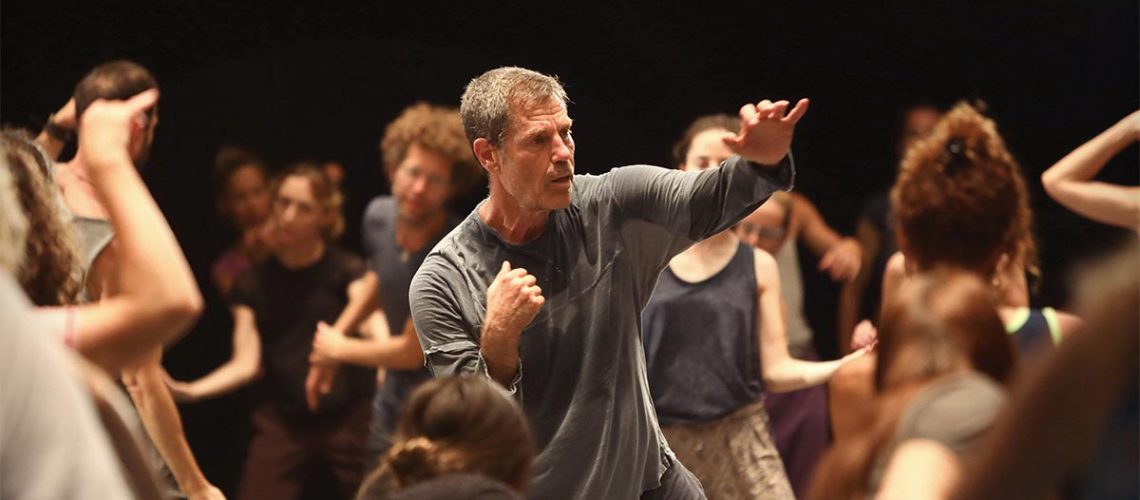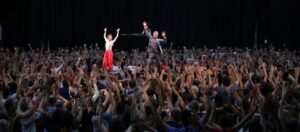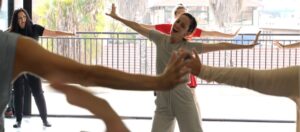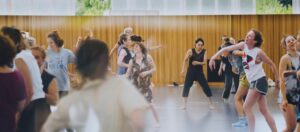By Michal Helfman
Time is a stage for the passing, for the choreography of events to occur and fade away. The acknowledgment of the temporality of all phenomena carries with it an existential feeling of both pain and gratitude. The same feeling that arises while viewing the works of Ohad Naharin. Naharin deeply understands this particular aspect of time, which in dance, more than in other artistic media, ties the spectator to the event, which disappears just a moment later without leaving any trace behind but the empty stage of time.
The acknowledgment of the temporality of all phenomena carries with it an existential feeling of both pain and gratitude. The same feeling that arises while viewing the works of Ohad Naharin. Naharin deeply understands this particular aspect of time, which in dance, more than in other artistic media, ties the spectator to the event, which disappears just a moment later without leaving any trace behind but the empty stage of time.
Concurrently, Naharin’s work involves a second dimension of time: concrete, that of the here-and-now, brought about by presenting the space of the political and its relationship to the subject’s domain of motion and freedom of expression. These two perceptions of time within a single choreography, and the transition from a timeless and existential perspective to one dictated by concrete circumstances, are what uniquely charge Naharin’s body of work.
In Venezuela (2017), Naharin translates the possibility of shifting between these two perspectives into a choreographic apparatus that itself contains both repetition and alteration. The format is built on the performance of the same choreography twice in a row. The most noticeable element that changes between the first and second versions is their soundtrack. In the first, Gregorian chants envelop the work in a slow, ambient meditation. That this music was written prior to modern times, and that it does not necessarily correspond with the inner development and dynamics of the choreography, creates a sense that we are outside of time. In the second part, however, the soundtrack is mostly more modern and more closely matches the choreography. This compatibility brings the work into sharper focus and locates us back in the “here-and-now”.
Another element that changes in Venezuela are the white cloths the dancers wield in the first part of the work, that later transform into abstractions of national flags in the second. This choreographic strategy and the fact that the dancers also change between the two sections is reflective, questioning the way in which interpretive meaning is given to a choreography. The recurrence of the same choreography twice is a testimony to its potential to repeat itself and a suggestion of viewing it as a deterministic phenomenon, unaffected by the circumstantial and temporal. On the other hand, it is precisely this change – flags and people – that comes from the political sphere, which in Venezuela colors our interpretation of the work as a whole.
Last Work (2016), already by its title, also locates itself in the political and questions the very possibility of artistic creation in our current political atmosphere. Prior to the emergence of the political, Last Work enjoys a prolonged period of “grace”, taking the time to slowly conduct itself as within a dream. The dancers gradually enter the stage, one at a time, enjoying the space of individual expression. As if freely floating, the entire scene detaches itself from the influence of outer conditions.
Gradually, Naharin violates this state, leading to a climax in which the dancers become the synchronized parts of a working machine. Together, they fuel themselves into an ecstatic unison, drunken with potency and power, completely blind to a manipulation schemed behind them. The work ends with a single character – a demagogue who was inciting the group the entire time – binding its members together in duct tape, transforming them into a paralyzed constellation, in which individuals as well as the entire group, are deprived of movement.
This image of immobility as both an actual state and metaphor, reflects a wider reduction of the space for human expression. Naharin presents this reduction vis-à-vis the endless potential of movement manifested by the dancers. He doesn’t express the political by collapsing the language into itself; in this sense, Naharin doesn’t defy dance’s traditional commandment of presenting a spectacle of moving bodies, grounded in constant propulsion and ongoing mobility.
Concerning this commandment – continuously deconstructed by the dance world in the past decade – Gaga, the movement language developed by Naharin, has a radical proposition of its own. A practice for training and choreography, Gaga is first a research tool, and as such, it aspires to remain an open code always in a state of becoming and subject to constant redefinition. Gaga is not built, as in the tradition of dance, on a syntax of a given vocabulary, but insead on the mindful instruction given by Naharin to his dancers, a compass for their interpretation. It is a dictionary, of which the writing never aspires to end and in which the terms are an invitation for a specific, yet subjective reading.
The dancers are both participants and active agents: the materials they discover through the process of improvisation in a Gaga class are sampled back into the language. Where Gaga infuses a choreography, it is a coherent language identified with Naharin but at the same time is saturated with the interpretation and co-formulation of all those who took part in the research.
Naharin’s work as a choreographer is inseparable from the ongoing formulation of Gaga, the DNA that generates the choreography from the inside. The combination of the two is an expression of Naharin and his dancers’ research of the humanist aspect that lies within the movement of the human body. While his works sweep the dancers – and with them the audience – into a multifaceted totality, they also sustain an external and self-reflective gaze, knowingly questioning the conditions and reality of our times. This double perspective not only points to power structures and their reductionist mechanisms, but also allows us to understand the depth and value that lies within freedom of expression and movement, and what we would lose if it were taken offstage.





